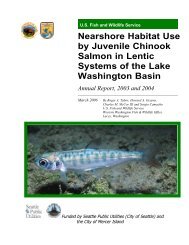2005 State of Mobility Report - City of Bellevue
2005 State of Mobility Report - City of Bellevue
2005 State of Mobility Report - City of Bellevue
You also want an ePaper? Increase the reach of your titles
YUMPU automatically turns print PDFs into web optimized ePapers that Google loves.
CHAPTER 7: Safety<br />
7-B. Highest Accident Intersections, <strong>2005</strong><br />
Location<br />
SE 26th Place at 128th Avenue SE 1.91<br />
SE Wolverine Way at 105th Avenue Se 1.69<br />
NE 2nd Street at 105th Avenue NE 1.69<br />
NE 21st Street at 100th Avenue NE 1.58<br />
Main Street at 102nd Avenue NE 1.50<br />
NE 4th Street at 102nd Avenue NE 1.31<br />
NE 10th Street at 110th Avenue NE 1.21<br />
Northup Way at West Lake Sammamish Parkway 1.18<br />
NE 8th Street at 112th Avenue NE 1.15<br />
SE 41st Place at Factoria Boulevard SE 1.14<br />
many accidents occur over time. <strong>Bellevue</strong> collects<br />
accident data and tracks accident trends through<br />
its Accident Reduction Program. Table 7-A displays<br />
the categories <strong>of</strong> police investigated traffic accidents<br />
in the city for the past five years. It also breaks<br />
out two subsets <strong>of</strong> traffic accidents — pedestrianinvolved<br />
and bicycle-involved.<br />
The data in the table reveals two important points<br />
about the safety <strong>of</strong> <strong>Bellevue</strong>’s transportation system:<br />
• The trend line for the number <strong>of</strong> accidents<br />
reflects a general decline over time — the fewest<br />
number <strong>of</strong> police-investigated accidents in more<br />
than ten years was recorded in 2004. There was a<br />
rise in reported accidents in <strong>2005</strong>, but still below<br />
the number reported in 2000. <strong>2005</strong> did see a<br />
significant increase in bicycle involved accidents.<br />
• The number <strong>of</strong> traffic related fatalities remains<br />
low. According to the U.S. Department <strong>of</strong><br />
Transportation’s Fatality Analysis <strong>Report</strong>ing<br />
System, there are 14.66 traffic accident fatalities<br />
for every 100,000 people. If this national statistic<br />
were applied to <strong>Bellevue</strong>’s population, we would<br />
anticipate more than 17 traffic accident fatalities<br />
each year. However, <strong>Bellevue</strong>’s annual average is 2<br />
traffic fatalities. There were no reported fatalities<br />
in <strong>2005</strong>.<br />
<strong>2005</strong> Rate<br />
The <strong>City</strong>’s accident data<br />
for any given year is further<br />
analyzed by location so<br />
that the highest accident<br />
intersections and mid-block<br />
corridors can be identified<br />
and monitored.<br />
Intersections<br />
An intersection accident<br />
rate is used to determine the<br />
relative number <strong>of</strong> accidents<br />
at any given intersection. The<br />
rate allows staff to compare<br />
intersections that serve a high<br />
volume <strong>of</strong> cars to those that serve a lower traffic<br />
volume. The intersection accident rate describes the<br />
number <strong>of</strong> accidents for every one million vehicles<br />
entering the intersection. A rate <strong>of</strong> 1.0 means<br />
one accident occurs for every million vehicles<br />
entering the intersection. The top 30 high accident<br />
intersections, as ranked by intersection rate, are<br />
identified each year for monitoring.<br />
Table 7-B lists the top 10 high accident intersections<br />
for <strong>2005</strong>. The full list <strong>of</strong> 30 for <strong>2005</strong> can be found<br />
in Appendix A-9.<br />
Highlights <strong>of</strong> this data include:<br />
• No intersection in <strong>2005</strong> had an accident rate<br />
higher than 2.0 (two accidents per million<br />
vehicles entering the intersection).<br />
• Five <strong>of</strong> the top 10 intersections are signalized,<br />
but the first four intersections are unsignalized.<br />
• An accident reduction project has already been<br />
completed at the fifth ranked location, Main and<br />
102nd Ave NE.<br />
Two <strong>of</strong> the intersections in the top ten in <strong>2005</strong> were<br />
also on the list in 2004 (Northup Way at West Lake<br />
56<br />
<strong>2005</strong> <strong>State</strong> <strong>of</strong> <strong>Mobility</strong> <strong>Report</strong> Chapter 7

















